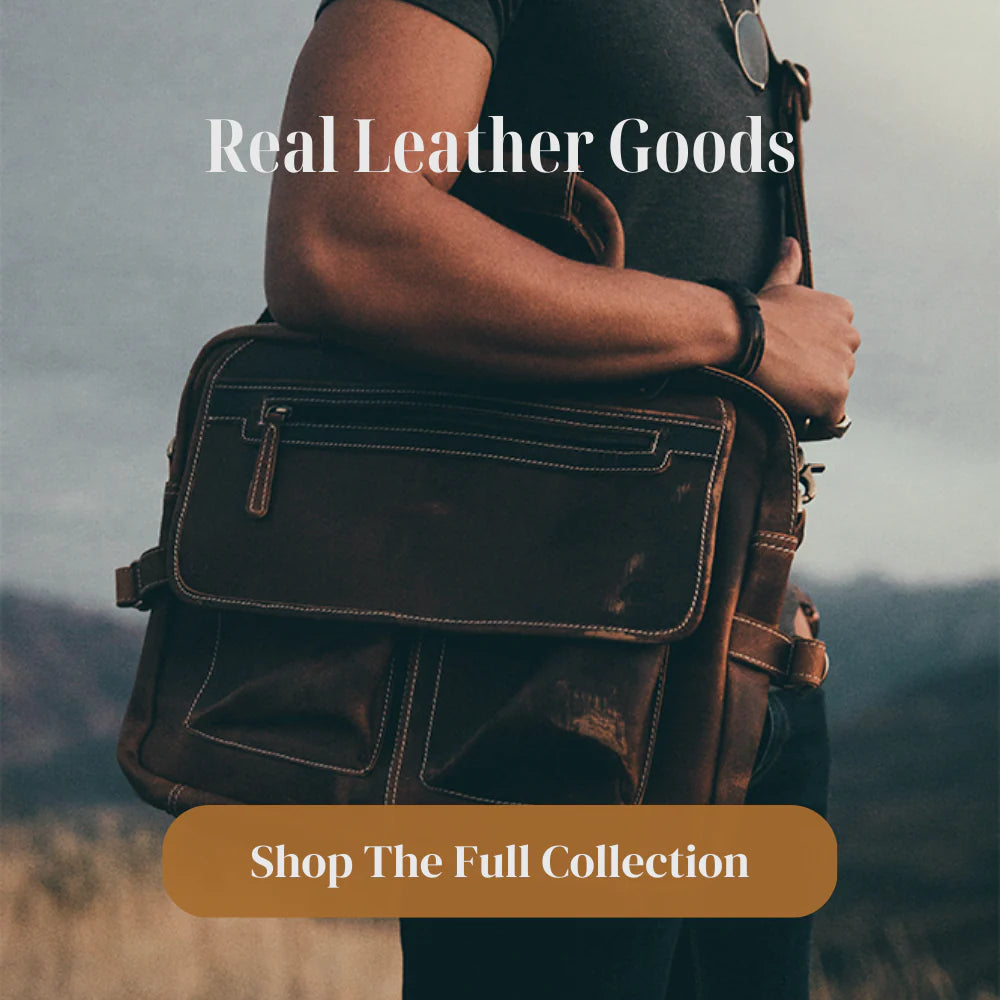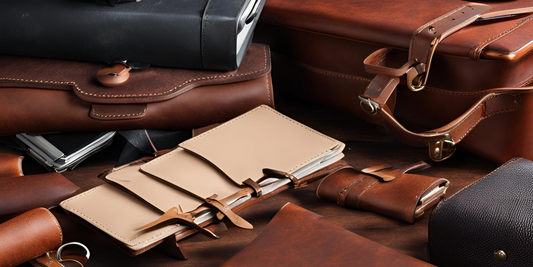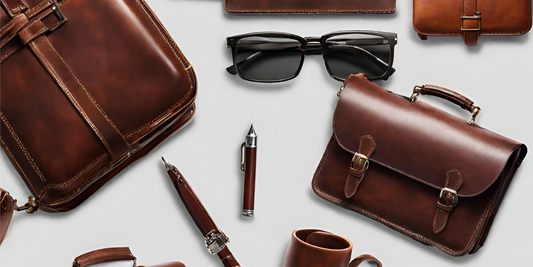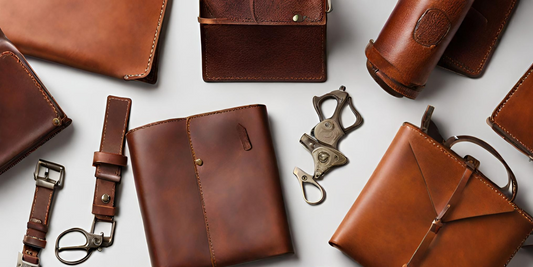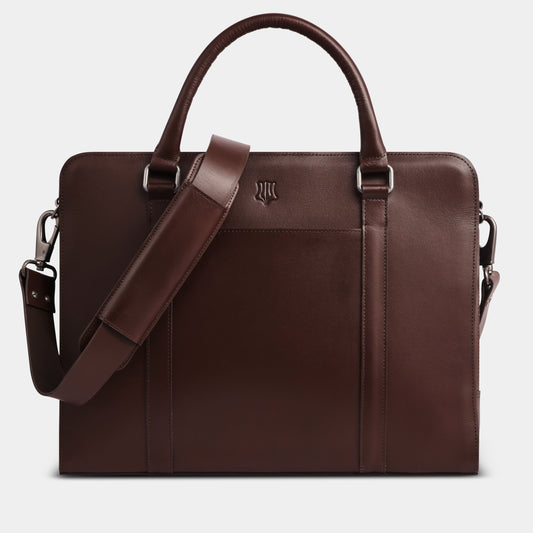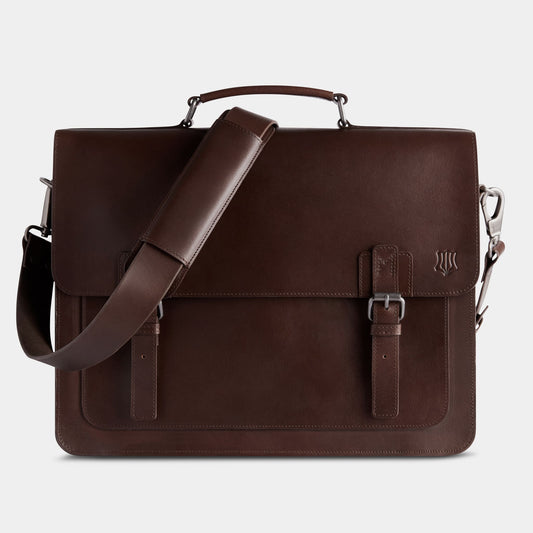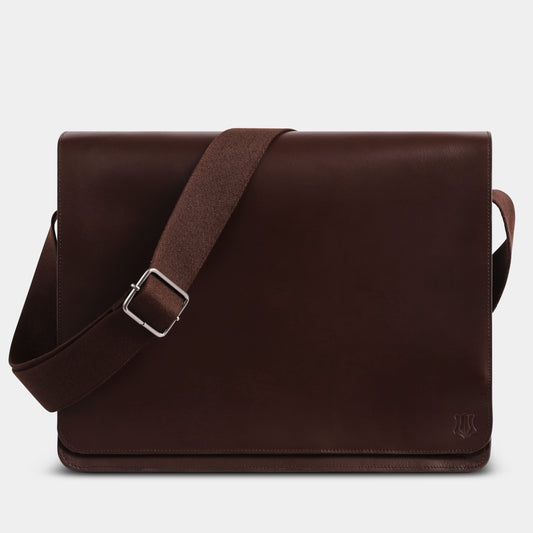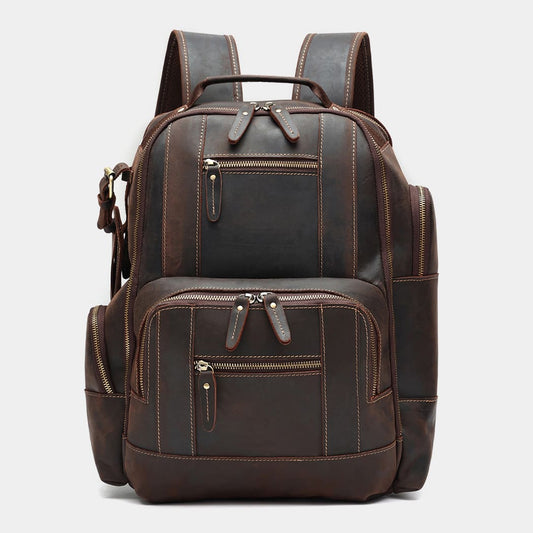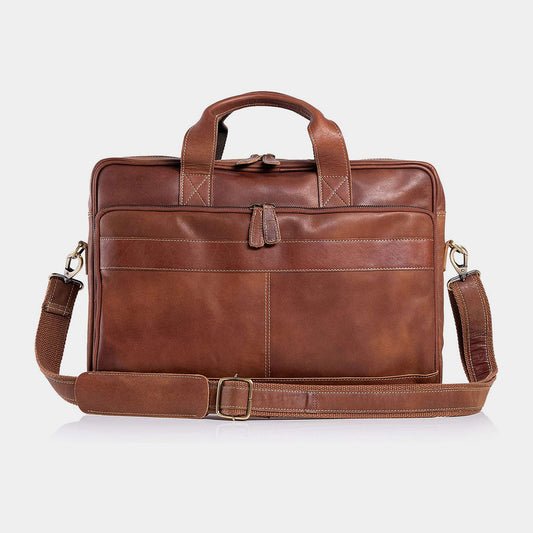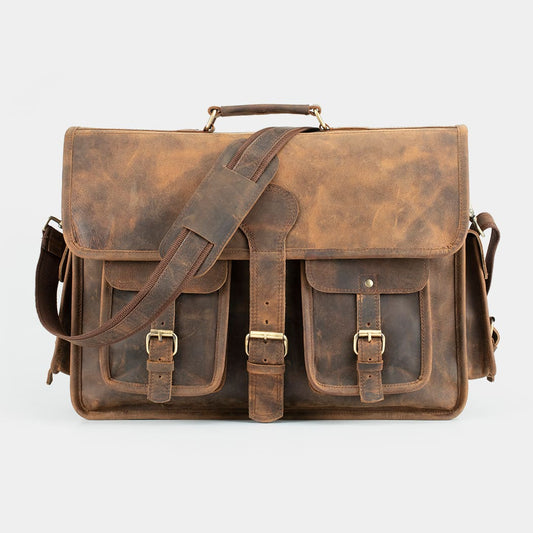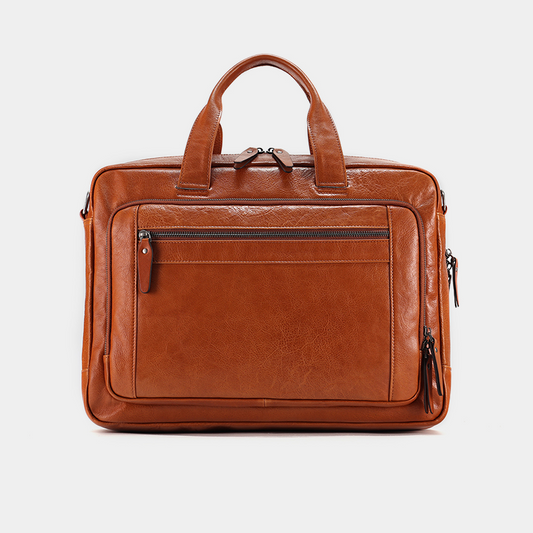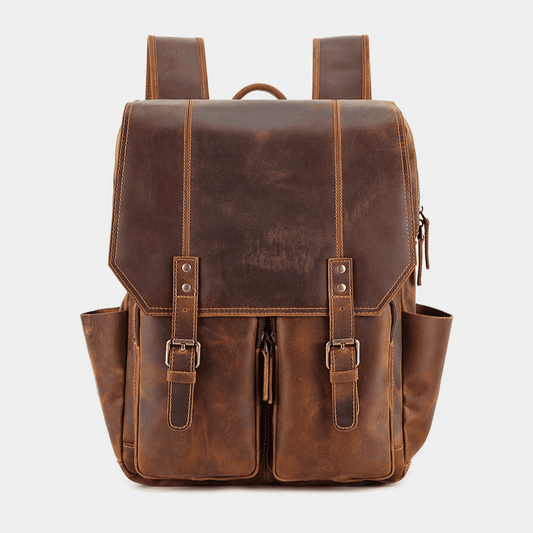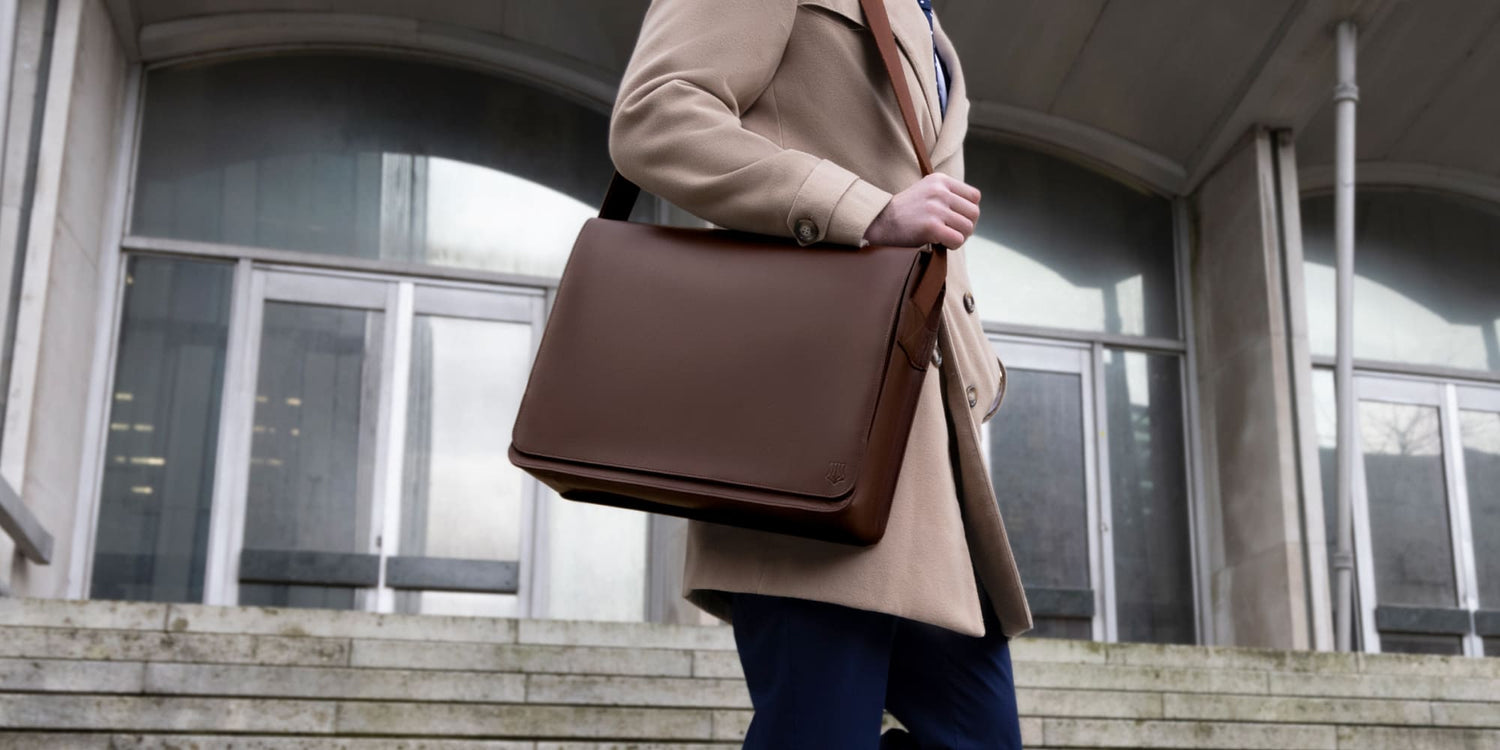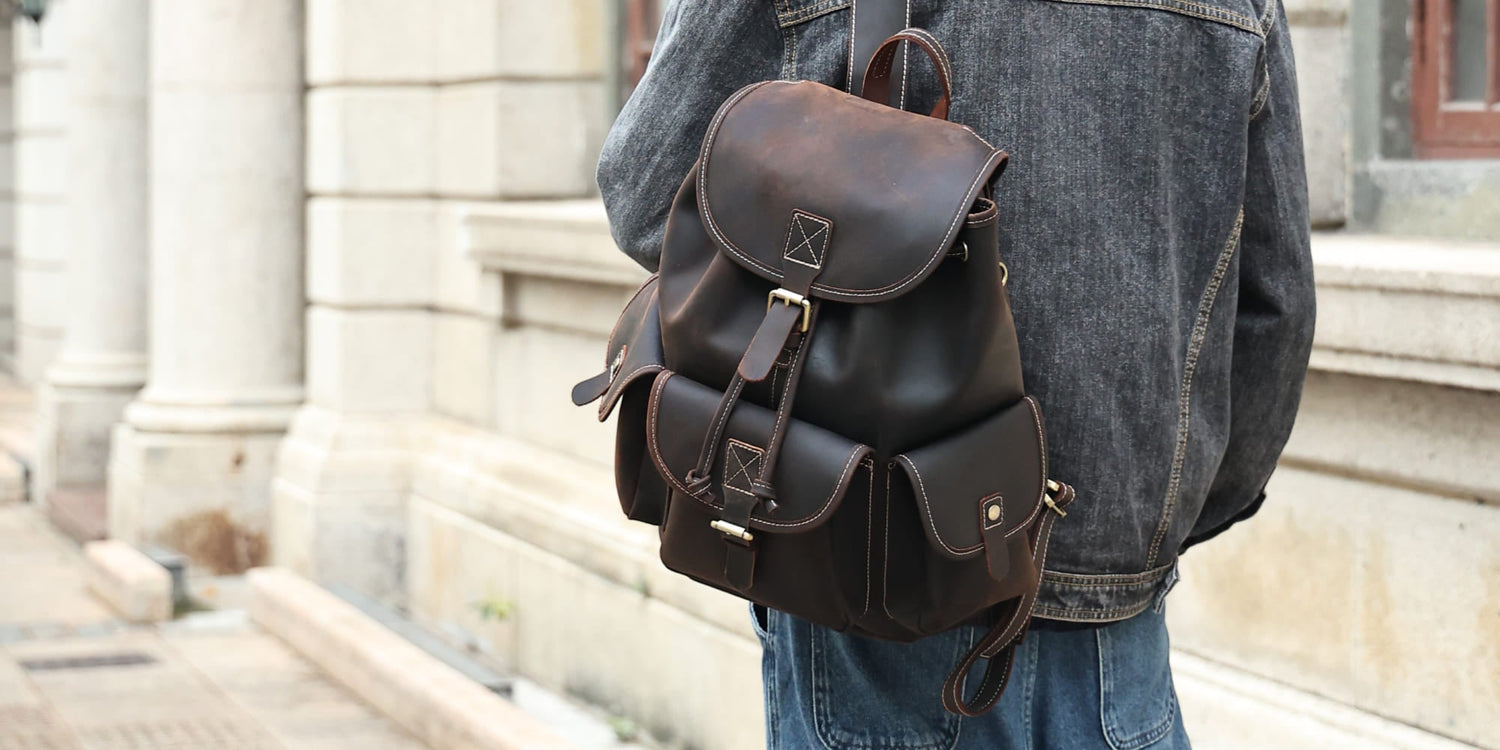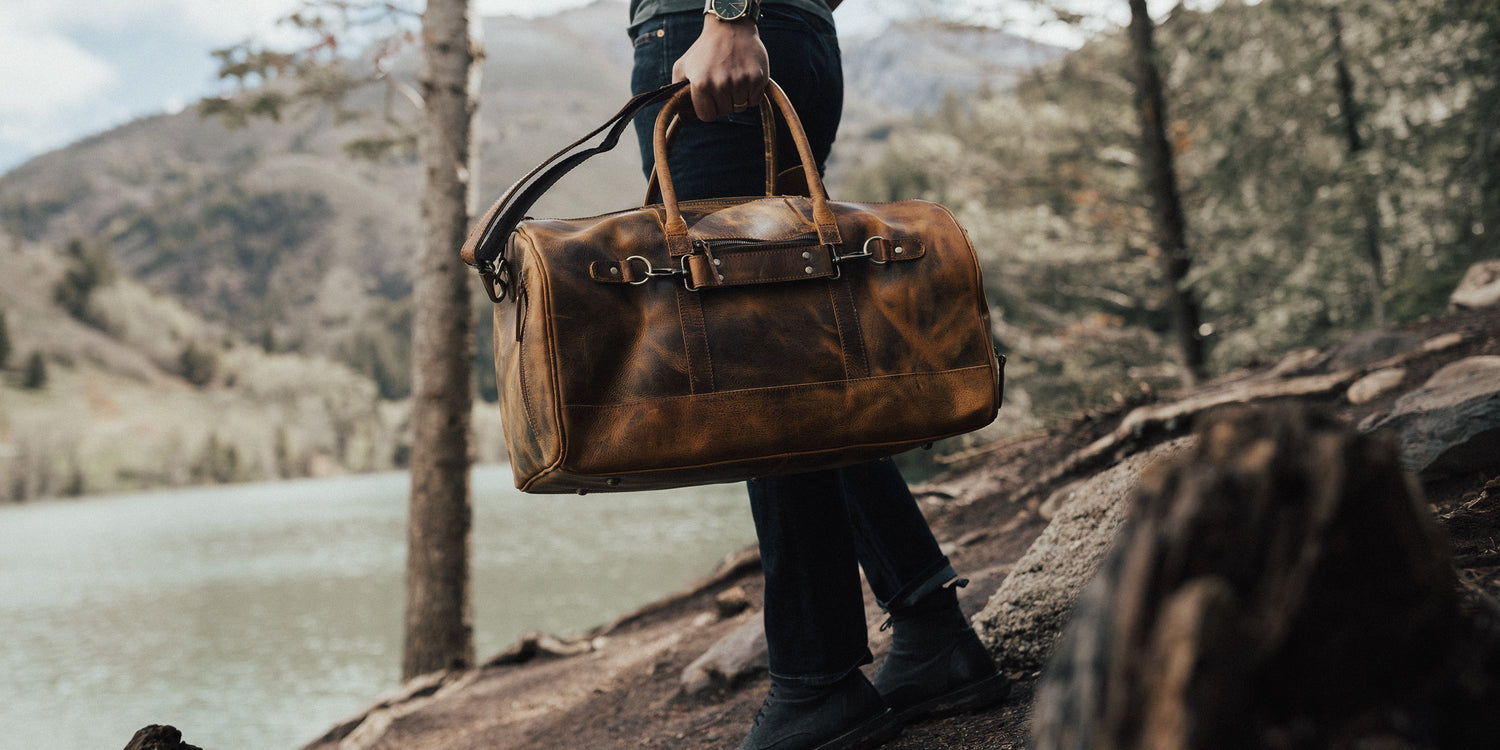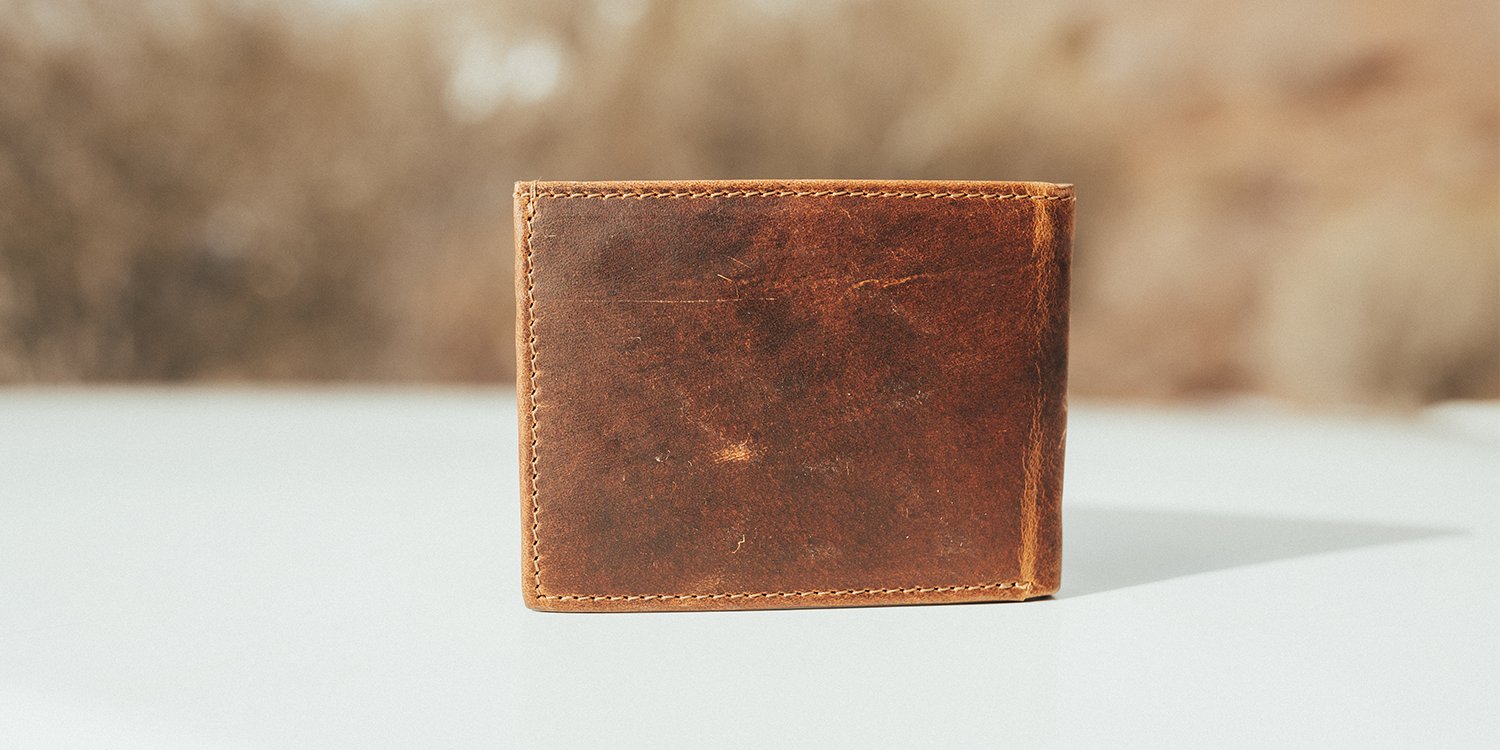Looking for leather goods that stand the test of time?
Genuine leather might seem like a convenient choice.
But be careful; it’s easy to be fooled by its name.
Sure, it’s cheap, and yes, it is considered real leather.
But beneath the surface lies a compromise.
In this article, you’ll learn exactly what genuine leather is and, perhaps more importantly, what it’s not.
What is Genuine Leather?
The term "genuine leather" is misleading.
And we believe, intentionally so.
It can confuse buyers into believing they are getting high-quality leather goods.
This is not always the case.
If a product is marked as genuine leather, that just means it contains some amount of real leather.
It could be 100% real leather or it could be 1% real leather.
Goods marked as genuine leather are not a guarantee, or even an indication, of quality.
We find that usually goods are marked as “genuine leather“ because they are trying to hide that they only contain a small amount of real leather.
For the purposes of this article, we will treat genuine leather as the most common, low quality leather variant that we see the most often.
TLDR: For luxury products, you want to look for top-grain and full-grain leather.
If you are buying leather goods as a gift for a birthday or anniversary, it’s important to understand the meaning of the phrase and what it can mean about the quality.
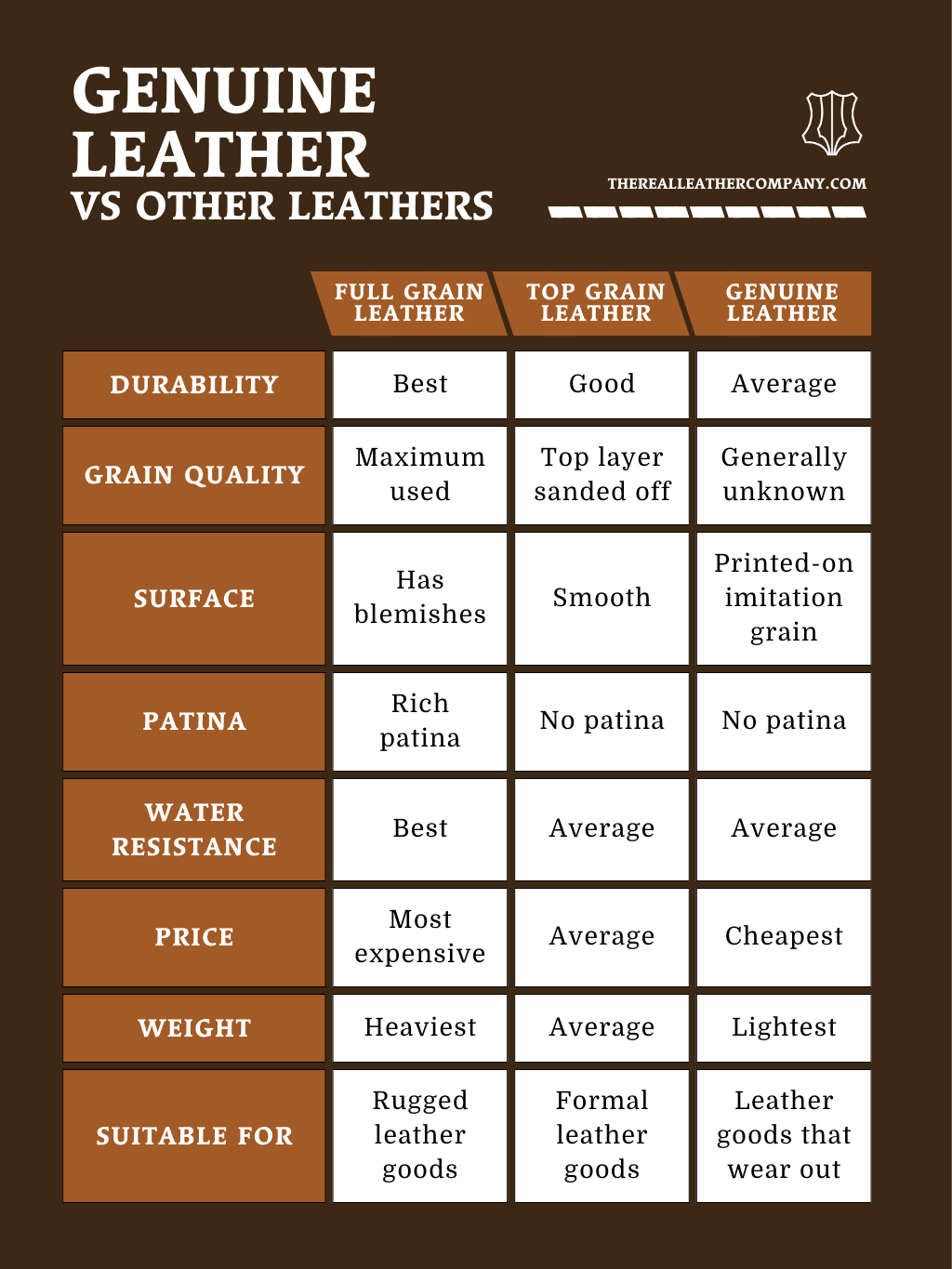
Is Genuine Leather Real Leather?
The term "genuine leather" can be misleading for some, leading to confusion about its authenticity and quality.
To put it simply, genuine leather is indeed real leather, but it's essential to understand where it stands in the hierarchy of leather grades.
Genuine leather is made from real animal hides, just like higher-grade leathers such as full grain and top grain.
However, it's important to recognize that genuine leather occupies the lower end of the quality spectrum.
While it may not boast the same level of craftsmanship or natural beauty as top-tier leathers, genuine leather is still a genuine and functional material with its own merits.
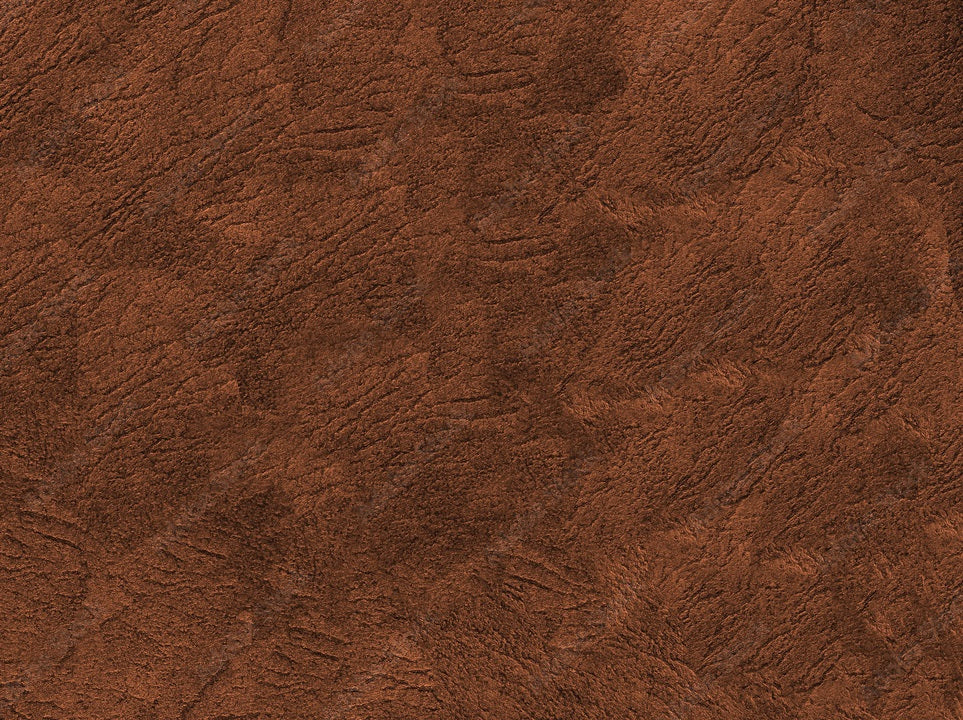
Understanding Leather Grades and Types
Leathers are usually graded by a tannery that separates and treats the hide.
A tannery will either produce chromium or vegetable tanned leather that then is graded on a scale.
Those who know a bit about leather bags and other goods will have heard material descriptions like full grain leather or top grain leather.
These are the two highest quality types of leather, often used to create luxury products.
They’re typically the most durable and aesthetically appealing options.
Sometimes genuine leather can be used to describe these high-quality materials, but it’s deceptive in that it also covers lower-quality options.
In most scenarios, there are five types of leather to be aware of. Here, they are ranked from the highest quality to the lowest.
1. Full Grain Leather
The most durable and highest quality section of the hide. It’s the very top layer of the hide and undergoes no chemical treatments.
It is the least processed and offers a nice, authentic look. Full grain leather is generally considered the highest quality leather and the best leather available.
Great for heirloom quality goods.
Check out our article on full grain leather.

2. Top Grain Leather
A higher quality leather that is still taken from the top layer of the hide.
It can be slightly softer and less durable than full-grain leather due to some treatment of the material.
Great for leather jackets.
For further information, check out our guide to top grain leather.
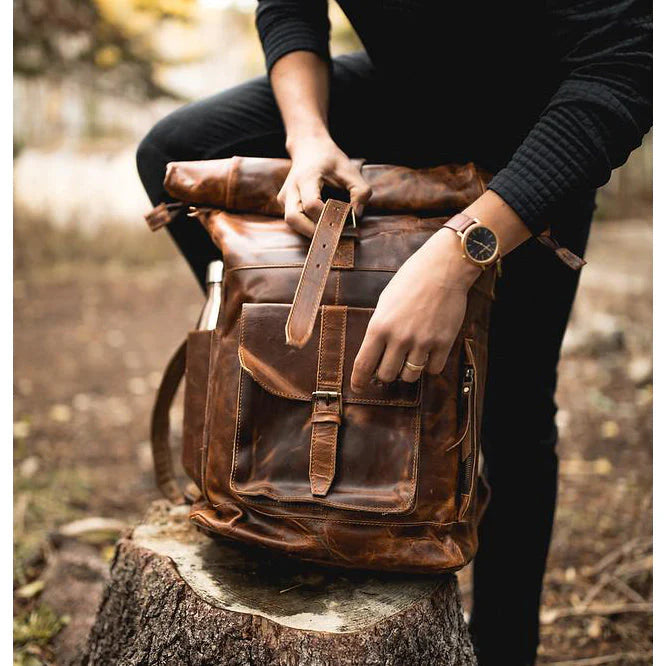
3. Split Grain Leather
This is sometimes referred to as corrected grain leather.
It’s a soft but weaker form of leather taken from the bottom of the hide.
It’s a mid range quality of leather that you would expect to last a long time.
Often, you might find some of the lower quality variants fall into the genuine leather category.
Great for leather furniture.
Suede is a common example of split leather.
4. Genuine Leather
As mentioned, this can be any grade or quality of leather. But here’s what we most commonly see referred to as genuine leather.
Most leather labelled as genuine leather is taken from the middle of the hide.
It doesn’t typically have the strength of full grain leather or the softness of split grain leather.
For the purposes of this guide, we will refer to genuine leather as this most-commonly seen lower quality type and grade.
5. Bonded Leather
A low-quality material made of leather scraps and leather dust bonded together. Generally the lowest quality of leather you can find.
Not a very durable material but it is affordable. Check out our guide to bonded leather.

Although this is common, the confusion comes because some businesses will describe all of these as genuine leathers, leaning into the more literal indication of them being ‘real’.
Genuine Leather vs Full Grain and Top Grain Leather
Genuine leather is not as resilient or sturdy as full-grain leather.
It lacks the richness of full grain or top grain leathers, and quite frequently, the difference is apparent.
Genuine leather products cost less than full-grain leather, but they are also less durable.
This may imply that they are suitable for products with lower wear, but for products like duffles, bags, purses and handbags, high-quality leathers will prove to be a far better long-term investment.
Advantages of Genuine Leather
Genuine leather, despite being a lower-grade leather, offers several advantages that make it a popular choice for a variety of applications:
1. Affordability
One of the primary advantages of genuine leather is its affordability.
Compared to higher-grade leathers like full grain and top grain, genuine leather is often more budget-friendly, making it accessible to a wider range of consumers.
This affordability makes genuine leather an attractive option for those looking for the look and feel of leather without breaking the bank.
2. Durability
While genuine leather may not possess the same level of durability as higher-grade leathers, the quality of the leather still offers decent strength and longevity.
With proper care and maintenance, genuine leather products can withstand regular use and maintain their appearance over time.
This makes genuine leather suitable for everyday items such as belts, wallets, and casual footwear.
3. Availability
Genuine leather is widely available, making it easy to find and purchase in a variety of retail outlets.
Its accessibility means that consumers have plenty of options when it comes to choosing genuine leather products, whether they're shopping online or in brick-and-mortar stores.
4. Versatility
Genuine leather is a versatile material that can be used in a wide range of applications. From fashion accessories to upholstery, genuine leather lends a touch of luxury and sophistication to various products.
Its versatility makes it a popular choice for manufacturers seeking a balance of quality, durability, and affordability.
Disadvantages of Genuine Leather
While genuine leather has its advantages, it's essential to be aware of its limitations and drawbacks:
1. Lower Quality
Compared to higher-grade leathers like full grain and top grain, genuine leather is considered lower quality.
It typically comes from the lower layers of the hide and may undergo more extensive processing to achieve a uniform appearance.
As a result, genuine leather may lack the natural beauty, durability, and longevity associated with higher-grade leathers.
2. Limited Aesthetic Appeal
Genuine leather may lack the distinctive grain patterns and character found in higher-grade leathers.
In particular, genuine leather will lack the patina found on full grain leather goods. It won’t get better with age and the leather will not develop.
Its appearance can be more uniform and less visually striking, which may not appeal to those seeking the unique beauty and individuality of natural leather.
3. Susceptibility to Wear and Tear
While genuine leather is reasonably durable, it may not hold up as well to wear and tear compared to higher-grade leathers.
Over time, genuine leather products may show signs of aging, such as creasing, cracking, and fading, particularly with frequent use and exposure to harsh conditions.
4. Environmental Concerns
The production of genuine leather, like all leather, involves the use of animal hides and various chemicals in the tanning process.
While efforts are made to minimize environmental impact, leather production can still have environmental consequences, such as water and air pollution.
Additionally, the demand for genuine leather contributes to the larger issue of animal agriculture and its environmental footprint.
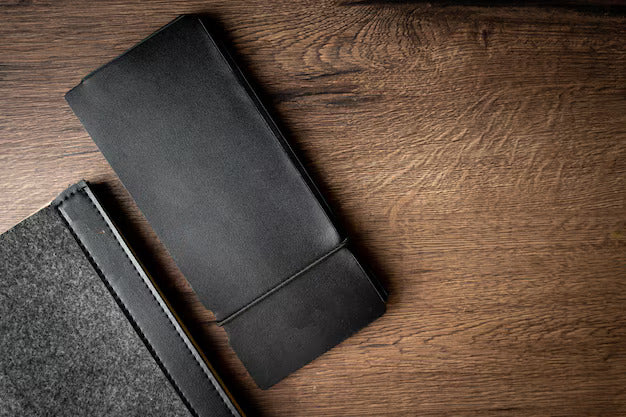
Genuine Leather Purchasing Tips
When shopping for genuine leather products, it's essential to know what to look for to ensure you're getting a quality item that meets your needs and expectations.
Here are some tips to help you make an informed purchasing decision.
1. Know Your Leather Types
Familiarize yourself with the different types of leather, including full grain, top grain, and genuine leather.
Understanding the distinctions between these grades will help you assess the quality and durability of the leather used in a product.
2. Check the Label or Description
Look for labels or product descriptions that clearly state the type of leather used.
Genuine leather products should be labeled as such, but be wary of misleading marketing language. Look particularly for the % of leather used - this can be a big giveaway if only a very small percentage is used.
If in doubt, ask the retailer or manufacturer for clarification.
3. Examine the Appearance and Texture
Inspect the leather for signs of quality, such as a consistent coloration, smooth texture, and natural grain patterns.
Genuine leather may have a more uniform appearance compared to higher-grade leathers, but it should still exhibit characteristics that indicate genuine animal hide.
4. Assess the Stitching and Hardware
Pay attention to the stitching and hardware used in the construction of the product.
Quality leather goods will feature sturdy stitching and high-quality hardware that complements the overall design.
Loose threads or flimsy hardware may indicate poor craftsmanship.
5. Research the Brand or Manufacturer
Do some research on the brand or manufacturer of the leather product.
Look for reputable companies known for their commitment to quality and craftsmanship.
Read customer reviews and testimonials to gauge the experiences of other buyers.
6. Consider the Price
While price isn't always an indicator of quality, genuine leather products are typically priced higher than synthetic or faux leather alternatives, but lower than full grain or top grain choices.
Be wary of products that seem unusually cheap, as they may be made from inferior materials or construction methods.

How to Care for Genuine Leather
Proper care and maintenance are essential to ensure the longevity and beauty of genuine leather products.
By following these simple tips, you can keep your leather items looking their best for years to come:
1. Regular Cleaning
Dust and dirt can accumulate on leather surfaces over time, dulling its appearance and causing premature wear.
To keep your leather clean, gently wipe it down with a soft, dry cloth or a slightly damp cloth.
Avoid using harsh chemicals or cleaning agents, as these can damage the leather's natural oils.
2. Conditioning
Leather is a natural material that can dry out over time, leading to cracking and stiffness.
To prevent cracking, regularly condition your leather products using a high-quality leather conditioner.
Apply the conditioner sparingly with a soft cloth, working it into the leather in a circular motion.
Allow the conditioner to penetrate the leather for a few minutes before buffing away any excess with a clean cloth.
3. Avoid Excessive Moisture
Leather is susceptible to damage from moisture, so it's essential to keep it dry whenever possible.
If your leather items get wet, gently blot away any excess moisture with a clean cloth and allow them to air dry at room temperature.
Avoid using heat sources such as hairdryers or radiators, as these can cause the leather to dry out and crack.
4. Protect from Sunlight and Heat
Prolonged exposure to sunlight and heat can cause leather to fade, dry out, and become brittle.
To protect your leather items, store them away from direct sunlight and heat sources such as radiators or fireplaces.
If storing leather items for an extended period, consider using a breathable storage bag or wrapping them in acid-free tissue paper to prevent moisture buildup and maintain their condition.
5. Handle with Care
Leather is a durable material, but it can still be prone to scratches, scuffs, and tears if mishandled.
Avoid dragging or scraping your leather items against rough surfaces, and be mindful of sharp objects that could puncture or tear the leather.
When not in use, store leather items in a cool, dry place away from potential hazards.
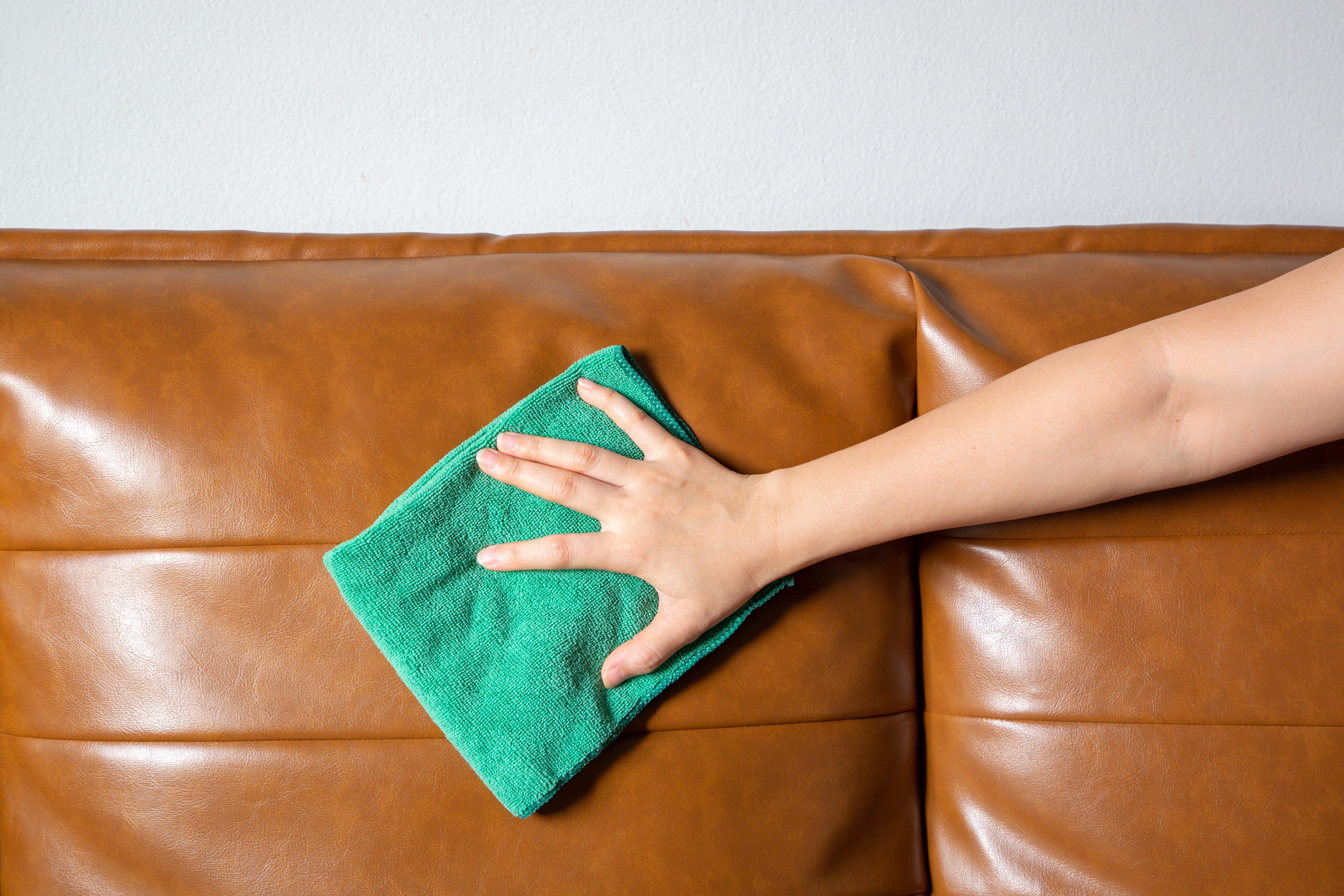
The Best Leather for Bags
When it comes to choosing the best leather for bags, we believe there's no room for compromise.
While genuine leather may be a common choice due to its affordability, savvy shoppers know that genuine leather simply doesn't cut it when it comes to quality and longevity.
Instead, discerning buyers turn to full grain and top grain leather for their superior characteristics and unmatched durability.
Whether you're looking for a statement piece to elevate your wardrobe or a reliable companion for everyday use, investing in a bag made from full grain or top grain leather is sure to exceed your expectations and stand the test of time.
At The Real Leather Company, we believe in high-end leather bags that are built to last long. Check out our best selling messengers, briefcases, wallets and more.
FAQs
1. What is genuine leather, and how is it different from other types of leather?
Genuine leather is made from real animal hides but comes from the lower layers of the hide.
It usually undergoes more processing compared to higher-grade leathers like full grain and top grain.
Genuine leather is considered a lower-quality grade of leather.
2. Is genuine leather durable?
While genuine leather is reasonably durable, it may not be as long-lasting as higher-grade leathers.
With proper care and maintenance, genuine leather products can withstand regular use and maintain their appearance over time.
3. How can I tell if a product is made from genuine leather?
Look for labels or product descriptions that clearly state the type of leather used.
Genuine leather products should be labeled as such, but be wary of misleading marketing language.
Additionally, genuine leather typically has a consistent coloration, smooth texture, and natural grain patterns.
To learn more about real leather, check out our collection of educational ebooks.
4. Can genuine leather be repaired if damaged?
Yes, genuine leather can often be repaired if damaged.
Minor scratches, scuffs, and tears can typically be repaired by a professional leather cleaner or repair specialist.
However, extensive damage may require more significant repairs or even the replacement of the leather item.
5. Are there alternatives to genuine leather for those concerned about animal welfare or the environment?
Yes, there are alternatives to genuine leather for those seeking more sustainable or cruelty-free options.
These alternatives include synthetic materials such as faux leather or PU (polyurethane) leather.
Vegan leathers are also available and are made from plant-based materials like cork, pineapple leather (Piñatex), and mushroom leather (Mylo).

